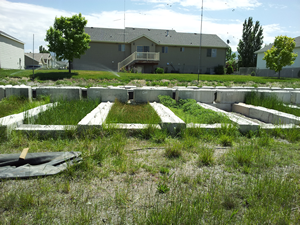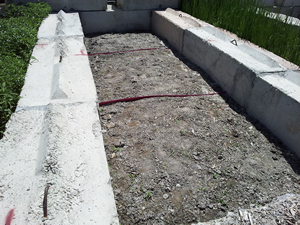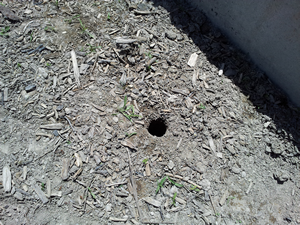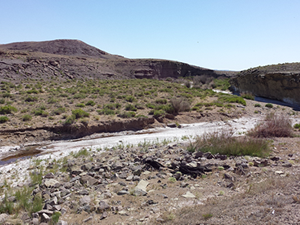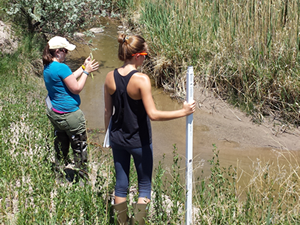iUTAH Undergraduate iFellows
Week 2 Recap
May 26-30, 2014
Allison Albert
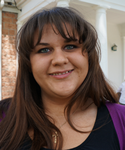 This week focused on getting the Green Meadows site up and running. My mentor, Margie Borecki, and I installed all of the edging at the site this week, and I bored the holes for the lysimeters and took soil samples. In addition to the work done on the site, Margie and I researched and purchased silica flour, betonite (ingredients needed for the installation of the lysimeters), and smaller lysimeters to sample water at a depth of 3 inches.
This week focused on getting the Green Meadows site up and running. My mentor, Margie Borecki, and I installed all of the edging at the site this week, and I bored the holes for the lysimeters and took soil samples. In addition to the work done on the site, Margie and I researched and purchased silica flour, betonite (ingredients needed for the installation of the lysimeters), and smaller lysimeters to sample water at a depth of 3 inches.
Tim Beach
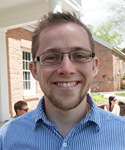 This week has been rolling along with some more data analysis for the hydrologic maps I am putting together. Sarah Null and I have been collaborating with various people, looking for data and ways to display the data that will be appealing to a general audience. One of the maps I am making is an average precipitation map of Utah, and it is getting close to being done. The GIS analysis for this map is complete, I just need to develop an overarching format for all of my maps and this particular map will be done.
This week has been rolling along with some more data analysis for the hydrologic maps I am putting together. Sarah Null and I have been collaborating with various people, looking for data and ways to display the data that will be appealing to a general audience. One of the maps I am making is an average precipitation map of Utah, and it is getting close to being done. The GIS analysis for this map is complete, I just need to develop an overarching format for all of my maps and this particular map will be done.
Toby Brotherton
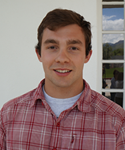 This week, Kenyon Gentry and I finalized a materials plan for the green roof arthropod diversity project. We then ordered and purchased some supplies. I am awaiting permission to bring materials into the lab and begin assembling them.
This week, Kenyon Gentry and I finalized a materials plan for the green roof arthropod diversity project. We then ordered and purchased some supplies. I am awaiting permission to bring materials into the lab and begin assembling them.
Andrew Butterfield
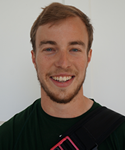 As my first official week in the Baker Lab, a lot of time was designated to introductions: introductions to people, introductions to various campus locations, introductions to research projects, and so on. Specifically, I was introduced to my project, the analytic instrument I will be using to collect data, and a good amount of relevant literature to read up on. I was able to take two trips outside the lab, once to a number of sites around Logan to conduct water sampling, and once up Logan Canyon to check out a new GAMUT station.
As my first official week in the Baker Lab, a lot of time was designated to introductions: introductions to people, introductions to various campus locations, introductions to research projects, and so on. Specifically, I was introduced to my project, the analytic instrument I will be using to collect data, and a good amount of relevant literature to read up on. I was able to take two trips outside the lab, once to a number of sites around Logan to conduct water sampling, and once up Logan Canyon to check out a new GAMUT station.
Kenyon Gentry
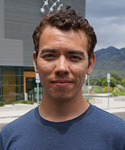 We finalized the supplies list for our project and began procuring materials. I did some data processing for our graduate Student Mentor, Youcan Feng.
We finalized the supplies list for our project and began procuring materials. I did some data processing for our graduate Student Mentor, Youcan Feng.
Adam Henrie
 I've spent the first half of the week packing envelopes with our survey to assess the attitudes of Salt Lake City residents towards landscaping practices. I then reviewed the IRB process with my mentor, whereby we will soon submit our research project proposal which will be to explore the perceptions of Utahans concerning Utah's water usage and sustainability.
I've spent the first half of the week packing envelopes with our survey to assess the attitudes of Salt Lake City residents towards landscaping practices. I then reviewed the IRB process with my mentor, whereby we will soon submit our research project proposal which will be to explore the perceptions of Utahans concerning Utah's water usage and sustainability.
Katy Hicks
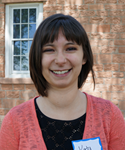 This second week has been mainly focused on coding newspaper articles that deal with any kind of water issue in Utah. I am still brainstorming for my research question.
This second week has been mainly focused on coding newspaper articles that deal with any kind of water issue in Utah. I am still brainstorming for my research question.
Alexis Holzwarth
 This week I was trained on how to use SPSS software to combine several data sets from excel into one large database of water use information. The purpose of our efforts is to provide a "big picture" of how water is used in an urban environment. This means determining who uses water for what, how much, how often, etc. By combining several sources, we now have a more holistic perception of urban water consumption within specific parcels.
This week I was trained on how to use SPSS software to combine several data sets from excel into one large database of water use information. The purpose of our efforts is to provide a "big picture" of how water is used in an urban environment. This means determining who uses water for what, how much, how often, etc. By combining several sources, we now have a more holistic perception of urban water consumption within specific parcels.
I have also been assisting Sarah Hinners in creating a data set composed of a list of plant species that could potentially be used for remediation. I search the scientific name of each potential candidate and retrieve information about the plant characteristics. Most important is how much water these plants require, their ability to withstand drought and spring flooding, as well as their ability to take in heavy metals and toxins from the soil and water.
Alongside both of these projects, I am contributing to the Metro Water Lab literature review. For this task I read articles from scientific journals about urban water use. I record these sources and briefly summarize for other researchers to use the information in their individual reports and papers.
Jeffery D. Josephson
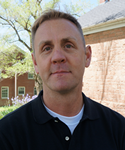 In finishing week two of the iFellowship I have found that sometimes research can be tedious--and then quickly that passes and I am back in the mindset that I can't think of another place I would rather be right now!
In finishing week two of the iFellowship I have found that sometimes research can be tedious--and then quickly that passes and I am back in the mindset that I can't think of another place I would rather be right now!
The setting here is wonderful. I have told all my friends and family how I get to read research paper after research paper and my notes become a part of the whole project. Again I am reminded how fortunate I am to have been chosen to play a part in iUTAH. Not just once, but twice.
I am now endeavoring to find the right subject for my own research paper and how that work can fit nicely into my studies at WSU and my senior project. The topics are wide and I can hardly chose between them--I want to know more about water management, supply and disposal, use and delivery, watersheds and their function and history, et cetera...
Claire O'Donnell
 Week 2 was a crazy mix of different projects. La'Shaye Ervin and I worked on 3 projects in the Pataki Lab. We started out by scouting mature Norway Maples and Golden Rain trees in Salt Lake City for La'Shaye's project. This project is studying trees on busy roads and if they are affected by a car's nitrogen output. We were much more successful in finding possible trees this time round. We also mailed out our first 530 surveys! We spent a lot of time stuffing envelopes so hopefully we have a good response rate. Finally, we worked on a project that will measure the biomass and Nitrogen-15 (15N) of different plots on campus that are using inorganic vs. organic fertilizer.
Week 2 was a crazy mix of different projects. La'Shaye Ervin and I worked on 3 projects in the Pataki Lab. We started out by scouting mature Norway Maples and Golden Rain trees in Salt Lake City for La'Shaye's project. This project is studying trees on busy roads and if they are affected by a car's nitrogen output. We were much more successful in finding possible trees this time round. We also mailed out our first 530 surveys! We spent a lot of time stuffing envelopes so hopefully we have a good response rate. Finally, we worked on a project that will measure the biomass and Nitrogen-15 (15N) of different plots on campus that are using inorganic vs. organic fertilizer.
Samuel Stout
 I was able to form some questions centered on my research this week with the help of Dr. Jackson-Smith and Dr. Flint. I am focusing on the urban planning and zoning relations to water usage and placement and hopefully provide info with the survey that we are doing over the summer.
I was able to form some questions centered on my research this week with the help of Dr. Jackson-Smith and Dr. Flint. I am focusing on the urban planning and zoning relations to water usage and placement and hopefully provide info with the survey that we are doing over the summer.
Anne Thomas
 Week 2 was still largely a training and preparation week; I started to work with the statistics program R (which will definitely stretch me), did some literature review, and started to outline what I'll be doing and the motivations for my project in proposal format. I also helped Mike Bunnell at his research sites in Heber.
Week 2 was still largely a training and preparation week; I started to work with the statistics program R (which will definitely stretch me), did some literature review, and started to outline what I'll be doing and the motivations for my project in proposal format. I also helped Mike Bunnell at his research sites in Heber.
Michelle-Kei Williams
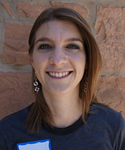 For this week’s update, I went with Graduate Student, Megan Walsh and Civil Engineering Intern, Kirsten, to the Pariette Draw Watershed in eastern Utah to collect soil samples at different location sites in the effort to analyze how & how much Total Dissolved Solids (TDS) are making their way into the Pariette draw stream system. Kirsten & I also assisted Megan with a cross section analysis of a stream within the Pariette draw & conducted a pebble count within the stream itself. I also ran the storm events at the storm site, collected influent & effluent samples, & then analyzed their nitrate & ammonia levels in the chemistry lab. I have also been given an assignment from my mentor, Dr. Christine Pomeroy to put together a literature review of synthetic storm water, in which I’ve been going through previous studies conducted on the bioretention of synthetic storm water.
For this week’s update, I went with Graduate Student, Megan Walsh and Civil Engineering Intern, Kirsten, to the Pariette Draw Watershed in eastern Utah to collect soil samples at different location sites in the effort to analyze how & how much Total Dissolved Solids (TDS) are making their way into the Pariette draw stream system. Kirsten & I also assisted Megan with a cross section analysis of a stream within the Pariette draw & conducted a pebble count within the stream itself. I also ran the storm events at the storm site, collected influent & effluent samples, & then analyzed their nitrate & ammonia levels in the chemistry lab. I have also been given an assignment from my mentor, Dr. Christine Pomeroy to put together a literature review of synthetic storm water, in which I’ve been going through previous studies conducted on the bioretention of synthetic storm water.

